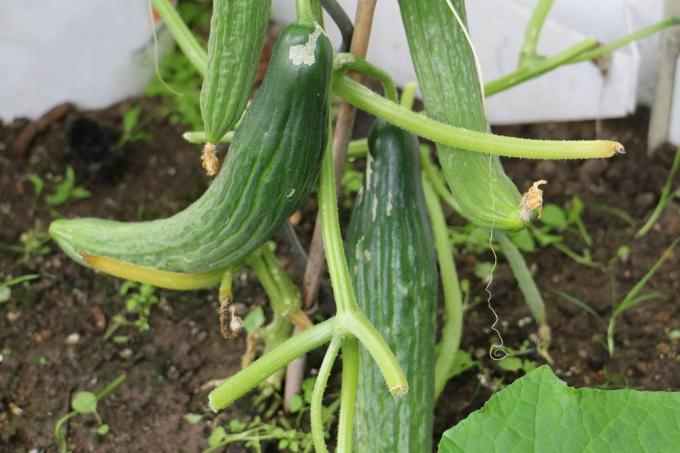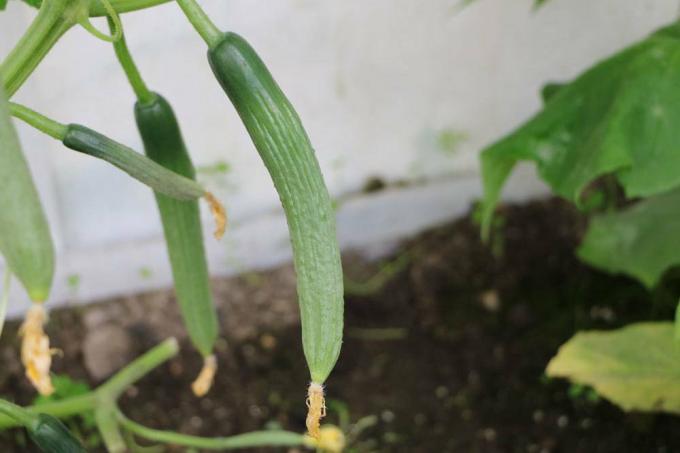
table of contents
- Greenhouse cucumbers
- sorts
- preparation
- Planting out
- care
- to water
- Fertilize
- Pricking and cutting
- temperature
- Diseases and pests
Cucumbers are a popular vegetable, especially on hot summer days. However, the taste of purchased cucumbers is often criticized. So why not grow the vegetables yourself? If the warmest place in the greenhouse is still free, then you have already found the ideal location for greenhouse cucumbers. And if you care for the cucumber plants properly, you can even harvest cucumbers several times per season.
Greenhouse cucumbers
sorts
There are various types of cucumber. As a rule, the varieties are classified according to their intended use, such as pickled cucumbers or cucumbers. The latter are also often called snake cucumbers. In the case of popular vegetables, however, a distinction is also made according to the form of cultivation. There are special varieties for outdoor cultivation and others that feel extremely comfortable in the greenhouse. As a rule, cucumbers are grown in greenhouses and pickled cucumbers outdoors. But there are also varieties that are suitable for both forms of cultivation.

Special greenhouse cucumbers are, for example:
- 'Helena' snake cucumber
- 'Fitness' snake cucumber
- 'Eiffel' cucumber
- 'Dominica' cucumber
- 'Paska' cucumber
- 'Printo' cucumber
- 'Picolino' mini cucumber
- 'Silor' mini cucumber
- 'Iznik' snack cucumber
preparation
Prepare the greenhouse
In order for the cucumber plants to grow well, the right one must be inside the greenhouse temperature prevalence. This applies to young plants as well as later to larger plants. Young plants like a warm soil. If the temperature falls below 10 ° C, they are extremely sensitive. Therefore, if you plant the greenhouse cucumbers out in April, you should insulate the greenhouse, for example with bubble wrap. Alternatively, you can put a heater in the greenhouse.
tip: If you want to be absolutely sure, insulate and heat. Alternatively, you can only plant the young plants out later, when the temperatures are higher.
The sun is of course the ideal source of warmth, but be careful, the plants don't like too much sun either. Especially on hot days you should make sure that the greenhouse cucumbers get shade, because the leaves of the cucumber plants burn easily in the sunlight. A shade that can be removed if necessary is best suited. Other plants are only conditionally suitable as shade providers, as they can also take away too much heat from the plants.
Prepare the soil
Before the young plants are planted out, the soil must be prepared accordingly:
- Loosen the soil
- fertilize with 3 to 5 liters of compost per square meter or an organic fertilizer
Once all the preparations have been completed, nothing stands in the way of planting out the greenhouse cucumbers.
Planting out
So that the young cucumber plants also thrive, you should only plant them out from a height of 20 centimeters. The ideal time for this is mid-May. The distance between the plants is also important, because cucumbers need a lot of space. Optimal is:
- 60 centimeters between the plants
- 150 centimeters distance in the row or
- one to two plants per square meter
However, cucumbers do not only need on the ground or Lots of space in the bucket, they also grow tall. Some cucumbers can develop tendrils of up to four meters. So you need one Trellis. Climbing cords from the roof of the greenhouse are suitable as a climbing aid. These are wrapped around the shoot in spirals.
tip: Re-wind the climbing cords twice a week so that the greenhouse cucumbers can develop well.
Warm feet
Cucumber plants like to have warm feet. To raise the temperature in the root area, you can black mulch film put on the ground. However, this should definitely be marked with holes or Slits are provided so that the irrigation water can also penetrate into the ground.
care
Greenhouse cucumbers are very, very thirsty plants. Watering is therefore the top priority when it comes to care.
tip: Cucumber plants don't like extremes. That is why they cannot tolerate fluctuations in temperature or in the water supply. Therefore, you should maintain them continuously.
to water
Even if the thirst of greenhouse cucumbers is great, they cannot tolerate too much water either. Therefore must Waterlogging must be avoided at all costs. In addition, the plants are also picky about the quality of the water, as they are extremely sensitive to lime, chlorine and salts. It is therefore best to water the greenhouse cucumbers with lime-free, lukewarm water. The ideal time to give water is in the morning.
tip: Lukewarm water should prevent the bitter taste of the fruit.
Fertilize
Fertilizer gives the plants nutrients and cucumbers Heavy consumers they need a lot of it. However, since many man-made fertilizers contain chlorine and various salts, you should bring the plants with them organic fertilizer fertilize. A thin layer of mulch, for example from lawn clippings, also promotes growth.
tip: Nettle manure is ideal for fertilizing the plants.
Pricking and cutting
If the cucumber plants begin to creep, you should prune the tips before the plants have reached the roof of the greenhouse. In addition, all side shoots of the plant are removed up to a height of about 80 centimeters. It is always cut after the first leaf attachment. This serves as a preventive measure against premature fruit growth, which considerably weakens the young plants.
tip: So that the main shoot of the plant does not become too long, it is shortened.
It is controversial whether pruning cucumber plants actually leads to higher yields. Proponents of the measures argue that sterile side or Side shoots of the plant cost an unnecessarily high amount of energy. By pricking out these "unnecessary" drives fall away and the energy is directed into the "right" drives. Opponents of showing off state that it makes no difference in terms of yield whether or not it is maxed out. It is best to check this for yourself using two plants. If pruning has led to a higher yield, you can continue to care for the plants.
temperature
Cucumber plants thrive best at a temperature between 20 ° C and 25 ° C. At these temperatures, however, you should make sure that the humidity does not become too high. Otherwise, dew will form at night and this literally attracts fungal diseases.
tip: Even if cucumbers need a lot of heat, you should ensure that there is good air exchange in the greenhouse.
Diseases and pests
If the leaves of the cucumber plants are light or even yellow, this indicates you Nutritional deficiency there. In this case, fertilizing will help. If cucumbers fall off the plant by themselves, the greenhouse cucumbers lack water or the temperature fluctuations in the greenhouse are too great.
Pests
Greenhouse cucumbers are not only a popular vegetable for humans, they also like pests such as spider mites or aphids to eat. Adhesive boards help against the infestation as preventive measures.
If the pests have already settled in, you should fight them with environmentally friendly measures. Chemical insect repellants are not recommended that you absorb the toxins while consuming the fruit. Beneficial organisms such as predatory mites, predatory bugs or reticulated winged fly are particularly good at combating pests.
tip: To prevent or To recognize early, check the undersides of the leaves of the plants regularly, because the infestation often comes almost overnight.
In greenhouses with great drought, powdery mildew must be combated. You can recognize its damage by the white fungal lawn on the leaves. To prevent infestation, you should plant the cucumber plants at generous intervals.

tip: A powdery mildew-resistant cucumber is, for example, the “Bella” variety.





